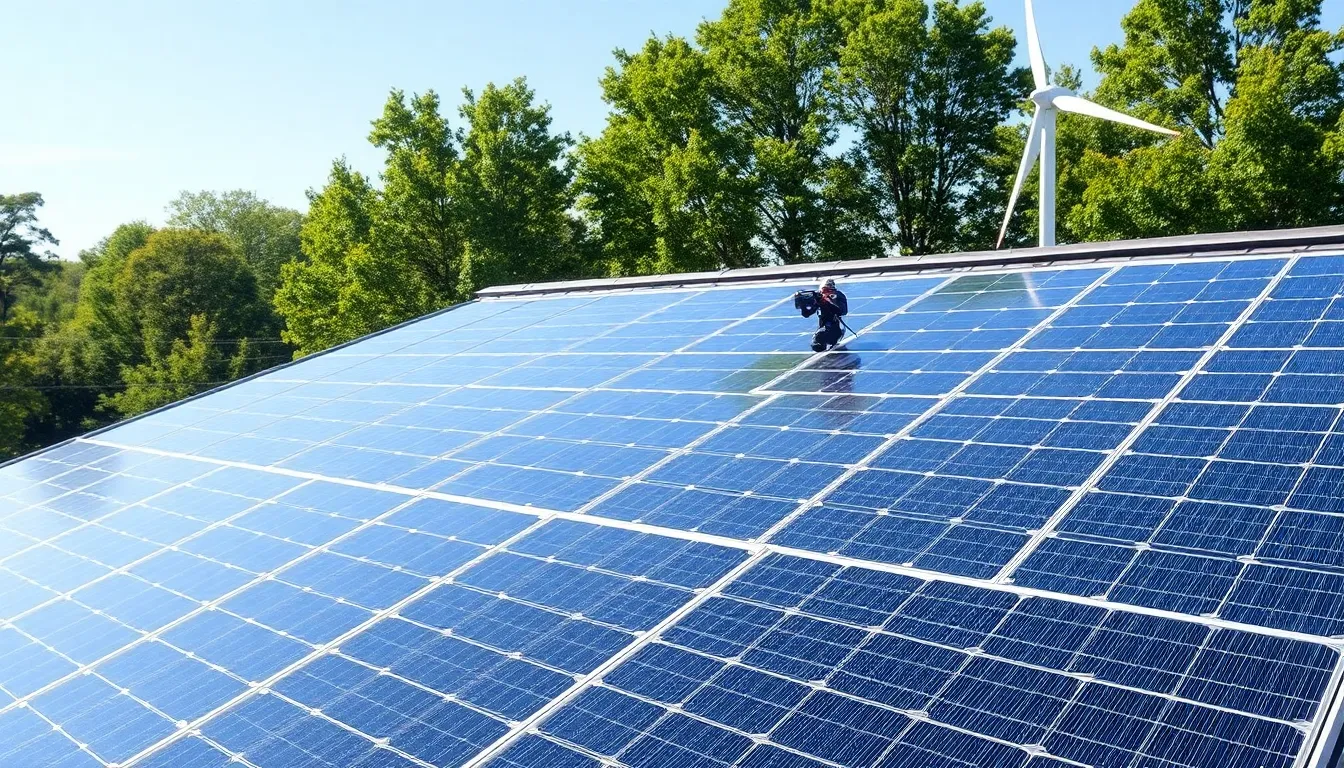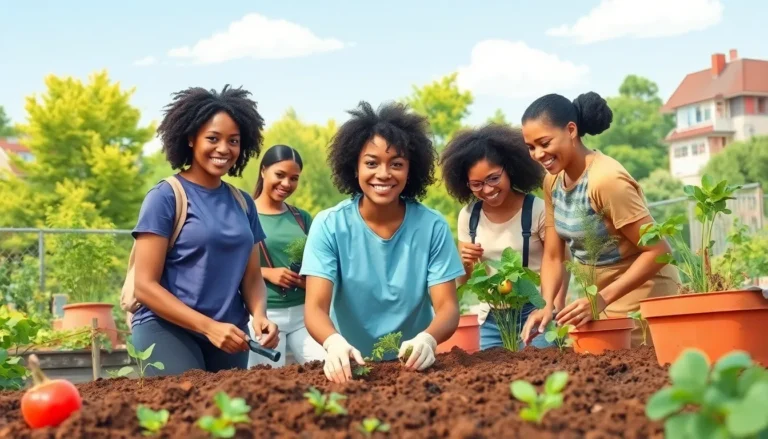In a world where plastic seems to outnumber people, sustainable living innovations are stepping in like superheroes in eco-friendly capes. These groundbreaking ideas are not just about saving the planet; they’re about making life easier, smarter, and a whole lot greener. Imagine a future where your morning coffee powers your home or where your garden grows food and friendship. Sounds like a dream, right?
Sustainable Living Innovations
Sustainable living innovations focus on reducing waste and enhancing resource efficiency. These advancements range from biodegradable materials to energy-generating systems incorporated into everyday products. Innovations in this realm aim to provide eco-friendly alternatives that lessen dependence on single-use plastics.
Garden designs featuring native plants represent another notable innovation. They support local ecosystems and require less water than traditional landscaping. Urban farming initiatives also promote local food production while minimizing transportation emissions.
Tech advancements play a significant role in sustainability as well. Smart home devices optimize energy consumption, reducing overall utility usage and lowering carbon footprints. These devices often integrate seamlessly with renewable energy sources like solar panels.
Materials science finds new innovations as well. Researchers develop plant-based plastics that decompose easily, negating the long-lasting environmental impact of traditional plastics. Compostable packaging solutions demonstrate potential in reducing landfill waste.
Transportation methods evolve too, with electric vehicles leading the charge. Their growing popularity contributes to cleaner air and lower greenhouse gas emissions. Bike-sharing programs and electric scooters increase urban mobility while decreasing traffic congestion.
Renewable energy technologies continue to advance rapidly. Wind and solar power generating systems become more efficient and affordable, facilitating their adoption across various sectors. Many communities invest in microgrid systems that enhance energy independence.
Sustainable living innovations reflect a collective movement toward a more resilient future. These diverse solutions aim to intertwine convenience with ecological responsibility, inspiring everyday individuals to embrace sustainable practices. By fostering awareness, communities galvanize efforts to adopt and promote these advancements.
Renewable Energy Solutions

Sustainable living innovations increasingly rely on renewable energy solutions to promote a cleaner environment. These options reduce dependence on fossil fuels, lower emissions, and enhance energy efficiency.
Solar Power Advancements
Recent developments in solar technology have made solar panels more efficient and affordable. Solar cells now achieve over 22% efficiency, allowing for greater energy conversion from sunlight. Innovative solar roofing options integrate seamlessly with traditional home designs while providing energy generation. Energy storage systems, such as advanced lithium-ion batteries, enable homeowners to utilize solar energy even during nighttime. Community solar programs also foster wider access to renewable energy benefits, encouraging group investments in solar initiatives.
Wind Energy Innovations
Wind energy continues to evolve with significant technological advancements. Modern wind turbines feature larger blades and improved aerodynamics, increasing energy capture by over 20%. Offshore wind farms harness stronger and more consistent winds, offering substantial energy output. Innovative floating turbine designs facilitate installations in deeper waters, expanding potential wind energy sites. Additionally, smart grid technologies allow for better management of wind power, ensuring stability and reliable energy distribution.
Waste Reduction Techniques
Waste reduction techniques play a crucial role in sustainable living. They help individuals and communities minimize their environmental impact and optimize resource use.
Composting Innovations
Composting innovations transform organic waste into nutrient-rich soil. Systems like vermicomposting use worms to accelerate decomposition, enhancing soil quality. In-home compost bins simplify the process, allowing residents to recycle kitchen scraps easily. Aerated composting methods increase oxygen flow, speeding up decay while reducing odors. Technologies that monitor moisture and temperature in compost enhance efficiency, ensuring optimal conditions for breakdown. These advancements empower households to contribute significantly to waste reduction by turning waste into a resource.
Upcycling Trends
Upcycling trends focus on reusing materials creatively, avoiding landfill waste. Fashion designers incorporate recycled fabrics into new collections, reducing textile waste and promoting sustainable practices. Home decor enthusiasts turn old furniture into unique pieces, showcasing individual creativity and reducing consumption of new materials. Innovative businesses gather discarded plastic for manufacturing new items, decreasing reliance on virgin resources. Community workshops encourage individuals to learn upcycling skills, fostering a collective spirit of sustainability. These trends not only address waste but also inspire innovative thinking and responsible consumption.
Sustainable Materials and Products
Sustainable materials and products represent a pivotal aspect of sustainable living innovations. These advancements help reduce environmental impact while enhancing daily life.
Biodegradable Alternatives
Biodegradable alternatives have gained significant traction, providing sustainable options for various applications. These materials decompose naturally, minimizing landfill waste and pollution. Examples include plant-based plastics, made from renewable sources, which replace traditional petroleum-based options. Research shows that bioplastics can break down within months, not years, unlike conventional plastics. Additionally, biodegradable tableware offers practical solutions for events, reducing the reliance on single-use plastics. Retailers embrace these options, ensuring greater consumer awareness and demand.
Eco-Friendly Packaging
Eco-friendly packaging is a vital component of sustainable living innovations. This type of packaging minimizes waste and environmental harm by utilizing renewable resources. Companies increasingly opt for materials like recycled paper, cardboard, and even mushroom-based products in their packaging designs. Statistics indicate that more than 70% of consumers prefer brands that prioritize sustainable packaging. By reducing plastic use, these companies not only meet consumer preferences but also enhance their brand image. Transitioning to eco-friendly packaging contributes significantly to the global reduction of plastic pollution.
Urban Agriculture Solutions
Urban agriculture presents innovative ways to ensure local food production while reducing environmental impact. These solutions contribute significantly to sustainable living and support community resilience.
Vertical Farming Developments
Vertical farming technologies harness small spaces for large yields. Systems like hydroponics, aquaponics, and aeroponics utilize minimal land while maximizing output. In cities, vertical farms integrate into buildings and rooftops, transforming urban landscapes. Research indicates that vertical farms can use up to 90% less water than traditional agriculture. Innovations in LED lighting optimize plant growth by mimicking natural sunlight, leading to faster harvest cycles. This approach allows urban populations to access fresh produce year-round, enhancing food security and reducing transportation emissions.
Community Gardening Initiatives
Community gardening fosters neighborhood connections and sustainability. These gardens empower individuals to grow their own food while utilizing local resources. By promoting the use of vacant lots and public spaces, residents can create green areas that enhance biodiversity. Participation in community gardens reduces food deserts and encourages healthier eating habits among participants. Studies show that neighborhoods with community gardens experience increased social interaction and community cohesion. Educational programs within these gardens teach sustainable practices, ensuring that urban farming continues to thrive and meet local needs.
Conclusion
Sustainable living innovations are reshaping how individuals and communities approach daily life. By integrating eco-friendly solutions into everyday activities, people can contribute to a healthier planet while enjoying enhanced convenience. The emphasis on renewable energy, waste reduction, and local food production not only supports environmental goals but also fosters community engagement.
As technology continues to advance, the potential for sustainable practices grows exponentially. From smart home devices to urban farming, these innovations empower everyone to make a positive impact. Embracing these changes paves the way for a future where sustainability is not just an option but a way of life, encouraging a collective movement toward resilience and ecological responsibility.





